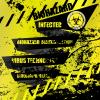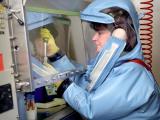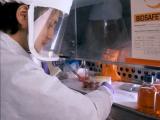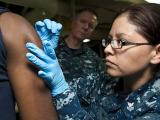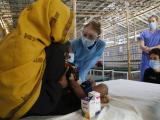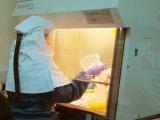In anticipation of today's debate at the National Academy of Sciences (NAS) in Washington, DC, on "gain-of-function" (GOF) research, two recent editorials and three other opinion pieces in mBio discussed the US government's decision earlier this fall to pause controversial GOF research that might elevate the risks of a pandemic as a result of a bioterror attack or accidental pathogen release.
"GOF" typically refers to experiments that involve enhancing the pathogenicity, transmissibility, or host range of a pathogen, with the aim of better understanding disease pathways and developing vaccines and drugs.
One editorial, by Marc Lipsitch, PhD, director of the Center for Communicable Disease Dynamics at the Harvard School of Public Health, and Thomas V. Inglesby, MD, director of the Center for Health Security at the University of Pittsburgh Medical Center, supports the research pause and offers approaches for assessing risk. The second editorial, by mBio editor Michael J. Imperiale, PhD, and mBio founding editor-in-chief Arturo Casadevall, MD, PhD, questions the value of the GOF pause and asks for clarification of key elements in the policy.
The Obama administration announced the moratorium on Oct 17 to assess the risks and benefits of federally funded GOF research involving influenza, MERS (Middle East respiratory syndrome), and SARS (severe acute respiratory syndrome) viruses and to develop federal policies. The National Science Advisory Board for Biosecurity (NSABB) is playing a lead role in the review, which is expected to last almost a year. On Nov 25 the NSABB expressed concerns over the pause.
The NAS symposium, held today and tomorrow by the NAS Board on Life Sciences, covers potential GOF risks and benefits and involves many of the researchers, epidemiologists, biosafety experts, and others who have been involved in the debate over enhanced-function experiments in the past several years. NSABB chair Samuel Stanley, MD, presented the results of the board's recent meeting.
Support for GOF pause
In delineating their support for the federal GOF moratorium, Lipsitch and Inglesby wrote, "Experiments that create the possibility of initiating a pandemic should be subject to a rigorous quantitative risk assessment and a search for safer alternatives before they are approved or performed. Yet a rigorous and transparent risk assessment process for this work has not yet been established."
Saying, "Risk assessment for GOF work should be quantitative, objective, and credible," they note that the record of accidents in biosafety level 3 (BSL-3) labs provides a starting point for quantifying the risk.
They present US data suggesting that a lab-year of experimentation on virulent, transmissible flu viruses might have a 0.01% to 0.1% chance of killing 2 million to 1.4 billion people in a pandemic, or a projected toll of 2,000 to 1.4 million fatalities per BSL-3 lab-year. Using data from only National Institute of Allergy and Infectious Diseases BSL-3 labs, the toll would be from 10,000 to more than 10 million deaths per lab-year.
Lipsitch and Inglesby point out that their estimates might overstate the risks because of several factors. For example, most GOF work is conducted in BSL-3-plus labs, not BSL-3 labs, and transmissibility in lab animals does not necessarily translate to transmissibility in humans. On the other hand, they note that the data they used do not include labs in other countries, one of the factors they say might actually understate the risks.
"These numbers should be discussed, challenged, and modified to fit the particularities of specific types of PPP [potential pandemic pathogens] experiments," they add.
They also call for calculating the risks associated with a potential deliberate misuse of PPP strains, such as a bioterror attack. "While the probability of this is likely to be very low for most scientists and most laboratories, it is not zero."
Assessing GOF benefits
As far as assessing the potential benefits of such studies, the scientists say that, on the surface, this step might seem more difficult. But, they add, "Scientists make judgments about the relative merits of experimental approaches on a daily basis in their roles as investigators and grant reviewers.
"The choice is not between doing PPP experiments and doing nothing. Rather, the appropriate question is, within a portfolio of scientific and public health activities designed to understand and combat influenza or a coronavirus (or, perhaps, in our portfolio of infectious disease countermeasures more broadly), what are the benefits of including PPP approaches compared to the benefits of expanding other parts of the portfolio to use the resources in another way?
"This comparative approach to benefits should be informed by a hard-nosed look at the benefits that are readily achievable by PPP experiments, not hypothetical outcomes that could someday lead to unspecified benefits. We acknowledge the possibility that PPP experiments may lead to benefits we cannot today envision. But so could the experiments that are done in their place if support for PPP is reallocated to other scientific approaches."
Two additional opinion pieces published by mBio highlight some of the perceived benefits already realized by GOF research. One piece, a commentary, is from officials with the Centers for Disease Control and Prevention (CDC). The other, an editorial, is by leading researchers, several of whom spoke today at the NAS symposium.
In the CDC commentary, the authors note, "Such GOF experiments have elucidated key biological principles and provided the scientific basis for genomic sequence-based risk assessment of zoonotic viruses with pandemic potential." One of the multiple examples they cite is the elucidation of the molecular basis for avian versus mammalian flu virus receptor binding.
Lipsitch and Inglesby, however, counter with, "The very presumption that we will see human cases of an incipient pandemic before that pandemic occurs has never been met in practice: we have never observed zoonotic cases of any flu virus before it caused a pandemic.
"This is not to deny that PPP experiments provide any useful data for surveillance and prioritization. Rather, it is to say that other approaches can also identify such predictors."
The two experts conclude, "A substantial number of scientists agree that there are extraordinary potential consequences of the work. . . . We believe that the responsible course is to take a research pause until such a risk assessment process is established, which creates a stronger basis for decisions and actions.
"This is not solely a scientific issue. It is a scientific and public health and safety issue, and it is an issue in which the public itself has an abiding interest."
Lipsitch and Inglesby add that they think the risk-benefit balance "is evidently unfavorable for experiments to enhance avian influenza virus transmissibility, but other classes of experiments may be different."
They also comment, "We have no interest in stopping scientists from doing their work or preventing laboratories from receiving funding. . . . There are more than 250 NIH-funded projects listed as active with titles containing MERS, SARS, coronavirus, or influenza, of which 18 have been affected by the funding pause."
Moratorium opposition
Imperiale and Casadevall, in contrast, point out several shortcomings of the research pause, which they say contains vague wording. They write, "Pauses and moratoriums are blunt instruments in science and carry the potential for unintended consequences."
Their first objection is that the policy has no defined time limit. "Will the NSABB and the Academies be nimble enough to make concrete recommendations that are broadly acceptable within months?" they ask. "Given the pace at which these committees generally function, we worry that this will not be the case."'
They also express concern over the phrase "reasonably anticipated." The federal policy stopped funding for "research projects that may be reasonably anticipated to confer attributes to influenza, MERS, or SARS viruses such that the virus would have enhanced pathogenicity and/or transmissibility in mammals via the respiratory route."
"Obviously," Imperiale and Casadevall write, "this phrase is very subjective, and similar wording in the definition of dual use research of concern (DURC) has already made assessments of what constitutes DURC very problematic for journals and authors.
"We therefore suggest that the intent of the experiment must be considered before making a determination of whether it should be paused."
The two scientists also agreed with the commentaries from CDC officials and flu researchers that the pause will disrupt crucial GOF experiments just as they are starting to bear fruit in pandemic preparedness.
As an example, they note a "tremendous need" for rodent models of coronaviruses with pandemic potential, including for MERS coronavirus. They say the moratorium affects two dozen such experiments.
Imperiale and Casadevall further worry about the effect of the pause on graduate students and postdoctoral fellows.
They also note that they both signed a statement from the Cambridge Working Group in July that called for more careful assessment of GOF experiments, something the pause is designed to do. To further underscore their unique perspective, they note that Imperiale signed a statement from Scientists for Science supporting GOF research shortly thereafter as well.
"While we both see important benefits for GOF work involving PPP," they comment, "we are nonetheless concerned about safety issues, and most importantly strongly support the common call for discussion. However, neither of us has supported the idea of a moratorium on this type of research."
They conclude, "Understanding the pathogenicity of these viruses is necessary if we want to develop new therapies and vaccines and ensure useful surveillance. Clearly, the research must be performed under biocontainment conditions that minimize the risk of accidental release."
But they add that a policy must be hashed out. "The discussion that the White House is asking for must occur because the status quo is not acceptable," they write. They call for clarification of the policy by government officials and ask that the NSABB and NAS move rapidly.
"We must get this right."
Call for better terminology
A fifth opinion piece suggests dumping "GOF" because it's a term used much more generally by researchers and causes confusion, a point made by experts across the spectrum.
W. Paul Duprex, PhD, a virologist at Boston University School of Medicine, and Casadevall suggest instead using "aTRIP." It stands for: alter (a), transmission (T), range and resistance (R), infectivity/immunity (I), and pathogenesis (P).
See also:
Dec 12 mBio editorial by Lipsitch and Inglesby
Dec 12 mBio editorial by Imperiale and Casadevall
Dec 12 mBio CDC commentary
Dec 12 mBio editorial by leading researchers
Dec 12 mBio editorial on GOF terminology
NAS notice of Dec 15-16 GOF symposium
Oct 17 CIDRAP News scan on GOF pause
Nov 25 CIDRAP News scan on NSABB meeting

